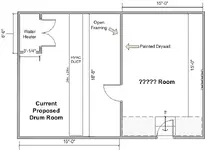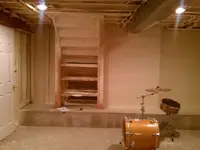E
eappleton1
New member
Hello all,
I posted some time ago when I was in the process of looking for a house regarding building a room for my drums. Well I finally have purchased a house and now I can get more into the specifics. My current only concern is to eliminate as much sound from coming out of the room through the house as possible. I would love it if no one upstairs had to hear me, or at least can only hear me faintly. I have a basement with a finished section and an unfinished section, the room room will be in the unfinished section which is about 3 feet underground with cement floors, walls, and no ceiling panels as of now.
The room is rather large so we cut it in half, as you will see in the included diagram. If you want to work off the diagram to add stuff, give me your email and I can send it to you:
You enter the unfinished basement in the right room that has 2 cement stairs leading down, as well as a ~3ft cement shelf across the width of the room. The room has a window on the right wall and has already been drywalled and painted. This room was originally what I thought would make the best drum room, I am not sure why our contractor felt otherwise. The contractor is a good friend of ours so I am not worried if we need to tear down the drywall and make this the drum room.
The plot gets thicker because the contractor's brother does industrial insolation (super dense white foam) and had him use what seems to be a thin coat on the open framing of the current drum room. I am not convinced that this will take care of my needs because it might be very dense and hard, but there's no mass to it. *SEE BOTTOM FOR PICS*
I understand the concept of building a room within a room as well as that sound is dampened by density, mass, depth, and vibration absorption, but things get hazy for me when it comes to what products are most effective for my specific room. I would love suggestions for wall and ceiling treatment, and come to understand that foam underneath carpet will probably be the best for the floors (correct me if I am wrong).
Main concerns:
-water heater room (should I frame and insolate around the room basically making a set of doors to get to the set of doors, or just get better solid doors and weatherproof them?)
-HVAC Duct (the duct runs the length of the room, what the hell should I do about that?!)
-Should I work with the room that got sprayed, or the windowed room and just tear down that dry wall?
Budget: $2000 (hopefully less, but able to do more if absolutely necessary)

Notice that powdery coating? That's the insolation. Also you can see the HVAC Duct. The drums are there because I wanted to see if the insolation did anything by itself: it didnt.
I posted some time ago when I was in the process of looking for a house regarding building a room for my drums. Well I finally have purchased a house and now I can get more into the specifics. My current only concern is to eliminate as much sound from coming out of the room through the house as possible. I would love it if no one upstairs had to hear me, or at least can only hear me faintly. I have a basement with a finished section and an unfinished section, the room room will be in the unfinished section which is about 3 feet underground with cement floors, walls, and no ceiling panels as of now.
The room is rather large so we cut it in half, as you will see in the included diagram. If you want to work off the diagram to add stuff, give me your email and I can send it to you:

You enter the unfinished basement in the right room that has 2 cement stairs leading down, as well as a ~3ft cement shelf across the width of the room. The room has a window on the right wall and has already been drywalled and painted. This room was originally what I thought would make the best drum room, I am not sure why our contractor felt otherwise. The contractor is a good friend of ours so I am not worried if we need to tear down the drywall and make this the drum room.
The plot gets thicker because the contractor's brother does industrial insolation (super dense white foam) and had him use what seems to be a thin coat on the open framing of the current drum room. I am not convinced that this will take care of my needs because it might be very dense and hard, but there's no mass to it. *SEE BOTTOM FOR PICS*
I understand the concept of building a room within a room as well as that sound is dampened by density, mass, depth, and vibration absorption, but things get hazy for me when it comes to what products are most effective for my specific room. I would love suggestions for wall and ceiling treatment, and come to understand that foam underneath carpet will probably be the best for the floors (correct me if I am wrong).
Main concerns:
-water heater room (should I frame and insolate around the room basically making a set of doors to get to the set of doors, or just get better solid doors and weatherproof them?)
-HVAC Duct (the duct runs the length of the room, what the hell should I do about that?!)
-Should I work with the room that got sprayed, or the windowed room and just tear down that dry wall?
Budget: $2000 (hopefully less, but able to do more if absolutely necessary)

Notice that powdery coating? That's the insolation. Also you can see the HVAC Duct. The drums are there because I wanted to see if the insolation did anything by itself: it didnt.
